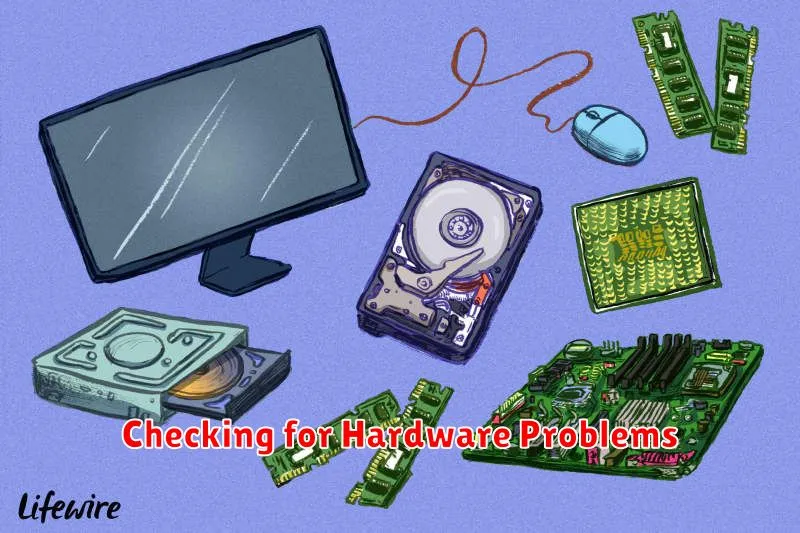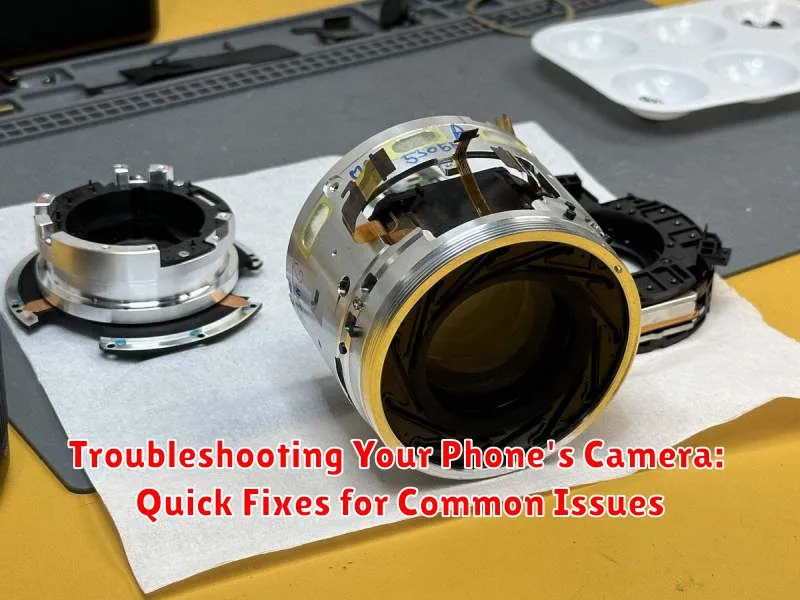Is your phone’s camera acting up? Are you experiencing blurry photos, unexpected crashes, or other frustrating issues? This article offers quick fixes for common camera problems on smartphones. We’ll guide you through troubleshooting steps to diagnose and resolve a variety of issues, from focus problems and poor image quality to app malfunctions and hardware failures. Learn how to quickly get your phone’s camera back in working order and capturing those perfect moments.
Whether you’re dealing with a black screen, a flash that won’t work, or simply want to improve your phone photography, this guide will provide practical solutions. We cover common problems across various phone models and operating systems, offering easy-to-follow instructions and helpful tips. Learn how to troubleshoot your phone’s camera effectively and get back to taking stunning photos and videos.
Common Reasons Why Your Phone’s Camera Isn’t Working
Several factors can cause your phone’s camera to malfunction. Understanding the root cause can help you troubleshoot more effectively. Sometimes, the issue is simple, like a temporary software glitch. Other times, a more serious hardware problem might be at fault.
Software Issues: A common culprit is a software bug or conflict. Outdated operating systems or camera apps can contain bugs that interfere with camera functionality. Conflicting apps running in the background might also prevent the camera from working correctly.
Hardware Problems: Physical damage to the camera lens or internal components can prevent the camera from operating. This might include a scratched lens, a faulty camera sensor, or a loose connection inside the phone.
Permissions and Settings: Incorrect camera permissions can also cause problems. If an app doesn’t have permission to access the camera, it won’t be able to use it. Similarly, incorrect camera settings within the app itself can lead to issues.
Low Storage or Battery: In some cases, low storage space or a low battery charge can affect the camera’s ability to function properly. Ensure you have sufficient storage available and that your phone has enough battery power.
Restarting Your Phone: A Simple First Step
Often, the easiest solution to a malfunctioning camera is a simple restart. This process can clear minor software glitches that might be interfering with the camera’s operation. Think of it as a quick refresh for your phone’s system.
To restart your phone, locate the power button, typically on the side or top of the device. Press and hold the power button until you see the power menu appear on your screen. Select the “Restart” option. Your phone will power off and then turn back on automatically.
After the restart completes, try opening your camera app again. In many cases, this simple action resolves the issue. If the problem persists, you can proceed to more advanced troubleshooting steps.
Checking for Software Updates to Resolve Bugs
Outdated software can often introduce bugs that affect your phone’s camera functionality. Checking for and installing the latest software updates is a crucial troubleshooting step. These updates frequently include bug fixes and performance improvements that can resolve camera-related issues.
To check for updates on your phone, typically navigate to your device’s settings menu. Look for a section named “Software Update,” “System Updates,” or something similar. The exact wording may vary depending on your phone’s operating system (e.g., Android or iOS). Tap on this section and follow the on-screen prompts to check for and install any available updates. This process might require your phone to restart.
Keeping your phone’s software up-to-date is not only important for resolving existing camera problems, but also for preventing future issues and ensuring optimal performance of all applications.
Clearing Camera App Cache and Data
Sometimes, accumulated cache and data within the camera app can lead to malfunctions. Clearing these can often resolve the issue without affecting your photos or videos (though it’s always prudent to back up your data regularly). The process varies slightly depending on your phone’s operating system.
For Android:
Typically, you’ll navigate to Settings, then Apps (or Applications). Find your Camera app in the list and select it. Within the app’s settings, you should see options for Clear Cache and Clear Data (or Storage). Try clearing the cache first. If the problem persists, clear the app data as well. Be aware that clearing data will reset the camera app to its default settings.
For iOS (iPhone):
While iOS doesn’t have a specific “clear cache” function for individual apps, offloading an app can achieve a similar effect. Go to Settings, then General, and select iPhone Storage. Find the Camera app in the list and tap on it. You’ll see an option to Offload App. This removes the app but keeps its data. Reinstalling the app (by tapping the app icon or re-downloading it from the App Store) will restore the data and potentially resolve camera issues.
Verifying App Permissions for Camera Access
Sometimes, camera issues arise not from hardware or software faults, but from incorrect app permissions. Your phone’s operating system controls which apps can access different hardware components, including the camera. If the camera app doesn’t have the necessary permissions, it won’t function correctly.
To check and adjust camera app permissions, follow these steps:
- Open your phone’s Settings app.
- Navigate to the Apps or Applications section (the name may vary slightly depending on your device).
- Locate and select your Camera app from the list of installed apps.
- Find the Permissions section within the Camera app’s settings.
- Ensure that the camera permission is enabled or allowed.
If the permission is already enabled, try toggling it off and then back on. This can sometimes resolve minor glitches. If you’re using third-party camera apps, repeat these steps for those apps as well. After adjusting permissions, test your camera to see if the issue is resolved.
Testing the Camera in Safe Mode to Isolate Issues
Safe mode is a diagnostic tool that allows you to run your phone with only the pre-installed applications active. This helps determine if a third-party app is causing your camera problems. If the camera works correctly in safe mode, a recently installed app is likely the culprit.
The process for entering safe mode varies slightly depending on your phone’s manufacturer. Generally, you’ll need to power off your phone. Then, during the restart process, hold down either the volume down or power button. Consult your phone’s documentation for the specific steps.
Once in safe mode, open your camera app and test its functionality. Take pictures and record videos to see if the issue persists. If the camera works as expected, exit safe mode and systematically uninstall recently added apps, testing your camera after each removal until you identify the problematic app.
Checking for Hardware Problems

Sometimes, camera issues stem from physical problems with the device. Inspect the camera lens for any smudges, cracks, or obstructions. Gently clean the lens with a soft, dry microfiber cloth. Avoid using liquids or abrasive materials. If the lens appears damaged, professional repair is likely necessary.
Check for loose connections. If your phone has recently been dropped or bumped, internal components might have shifted. While disassembling your phone isn’t recommended unless you’re experienced, you can sometimes gently tap the phone against your palm (battery area) to see if this resolves any connection problems. If you suspect internal damage, consult a qualified technician.
Test the camera in multiple apps. If the camera functions properly in some apps but not others, the problem likely lies with the specific app, not the hardware. However, if the camera malfunctions across all apps, a hardware problem is more probable.
Troubleshooting Camera App Conflicts
Sometimes, conflicts between the camera app and other applications or software can lead to camera malfunctions. Try these steps to identify and resolve such conflicts.
Checking for Recently Installed Apps
Recently installed apps can sometimes interfere with the camera’s functionality. Think back to when the camera issues began and if they coincided with any new app installations. If so, try uninstalling these apps one by one to see if the camera functionality returns.
Clearing Camera App Data and Cache
Corrupted data or a full cache in the camera app itself can also cause problems. Access your phone’s settings, find the application manager, locate the camera app, and clear its cache and data. Note that this might reset camera settings to default.
Software Updates
Ensure your phone’s operating system and the camera app itself are running the latest software versions. Outdated software can contain bugs that affect camera performance. Check for system updates in your phone’s settings and update the camera app through your device’s app store if necessary.
Factory Reset as a Last Resort

If all other troubleshooting steps have failed to resolve your camera issues, a factory reset might be the final solution. Be aware that this will erase all data on your phone, so it’s crucial to back up important files, photos, and contacts beforehand. A factory reset restores your phone to its original settings, potentially eliminating any software conflicts or corrupted data affecting the camera.
The process for performing a factory reset varies depending on your phone’s make and model. Generally, you can find this option within the “Settings” menu, often under “System” or “Backup & reset.” Consult your phone’s user manual or manufacturer’s website for specific instructions.
After the reset, set up your phone as new and test the camera. If the issue persists, it’s highly likely a hardware problem requires professional repair.

